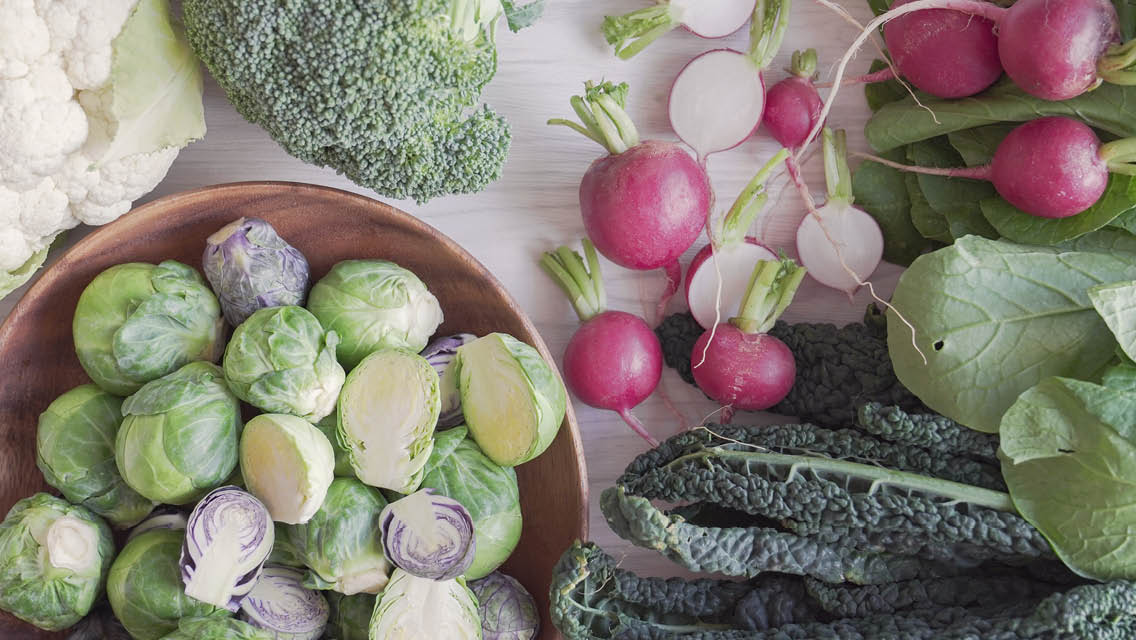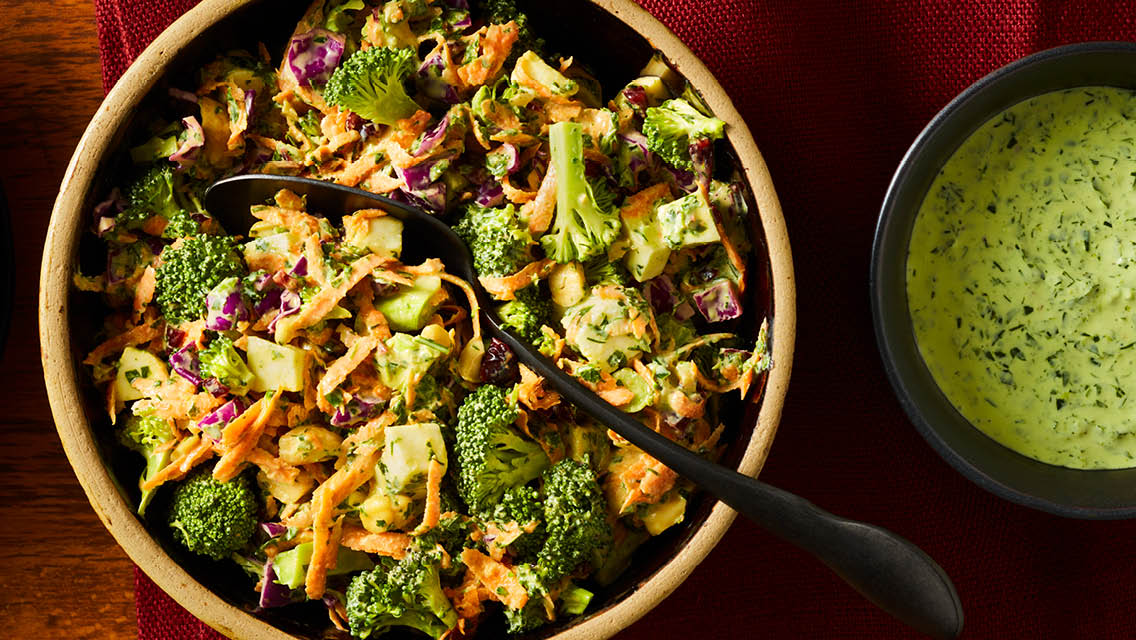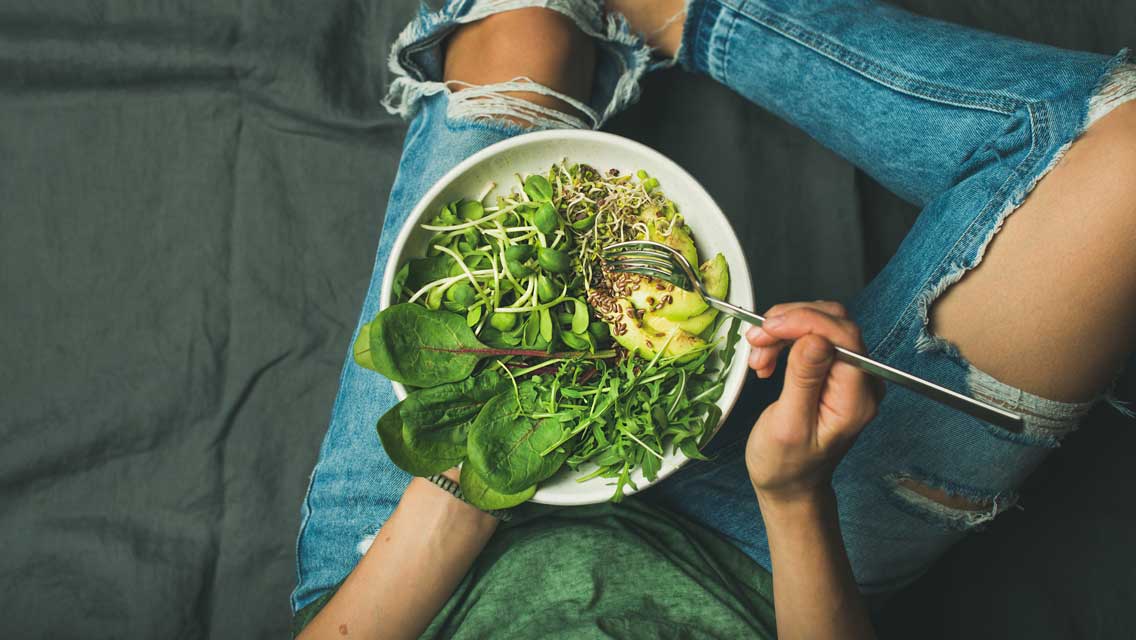Explore this article:
- What’s in a Crucifer?
- How Do Crucifers Affect Digestion?
- Can Eating Crucifers Affect Thyroid Function?
- Should I Cook Crucifers Or Eat Them Raw?
- 9 Cruciferous Veggies and How to Enjoy Them
Some people get flowers or trees tattooed on their skin. Not Jesse Haas, CNS, LN, a functional nutritionist at Wellness Minneapolis — her shoulder sports a leafy cabbage.
“I’m just really impressed by this plant family,” she explains. “They’re so powerful.”
The plant family Haas refers to is cruciferous vegetables, sometimes called brassicas. Members of the Brassicaceae family of flowering plants, crucifers are a diverse bunch. Some, such as maca, horseradish, radishes, wasabi, and rutabagas, are root vegetables. Others, including arugula, bok choy, cabbage, chard, collards, mustard greens, watercress, and kale, are leafy greens. And a few, such as turnips, broccoli, cauliflower, and kohlrabi, have multiple edible parts, from roots and leaves to florets and stalks.
Studies have found that crucifers — especially one of their main compounds, sulforaphane — benefit metabolic and heart health, notes functional-nutrition researcher Deanna Minich, PhD, author of Whole Detox and The Rainbow Diet. Sulforaphane may also support detoxification, reduce oxidative stress and inflammation, prevent neurodegeneration and certain cancers, and protect the lining of the gastrointestinal tract.
“People often say, ‘Eat your broccoli,’ but they don’t really understand how crucifers play a tremendous role in our biochemistry and physiology,” says integrative dietitian Mary Purdy, MS, RDN, author of The Microbiome Diet Reset.
What’s in a Crucifer?
Most crucifers contain vitamins C and K, folate, potassium, calcium, selenium, and fiber. But what sets them apart from other vegetables — and provides many of their impressive health benefits — are sulfur-containing chemical compounds called glucosinolates.
In crucifer cells, glucosinolates and the enzyme myrosinase are physically separated, but when the vegetables are chopped or chewed, these substances combine to create new compounds called metabolites.
Among these metabolites is sulforaphane. In the liver, sulforaphane stimulates production of the body’s master antioxidant, glutathione. (For more on this, see “Glutathione: The Great Protector“.)
A 2011 study in the European Journal of Clinical Nutrition found that eating sulforaphane-rich broccoli sprouts significantly reduced oxidative stress among people diagnosed with type 2 diabetes. A 2012 study in the International Journal of Food Sciences and Nutrition showed that consuming 10 grams of powdered broccoli sprouts daily for four weeks improved insulin resistance in type 2 diabetes patients.
And a 2014 placebo-controlled, randomized study found that broccoli-sprout extract improved autism symptoms in young men. The researchers noted that sulforaphane “upregulates genes that protect aerobic cells against oxidative stress, inflammation, and DNA damage,” all of which play a role in the condition.
Other studies have linked sulforaphane to improvements in asthma symptoms, and — thanks to its protective effects against oxidative stress in the brain — mitigation of some symptoms of chronic neurodegenerative diseases.
“Sulforaphane is pretty major in terms of disease prevention and treatment,” says Haas. “In functional nutrition we ask, ‘How do we help the body heal itself?’ Sulforaphane is one of those compounds that can support that.”
Sulforaphane can be especially helpful in supporting liver function, notes Purdy. “It increases the liver’s ability to deliver enzymes that help with detoxification and biotransformation.”
In these processes, compounds that might be toxic to the body — such as excess hormones or environmental chemicals — can be released and eliminated.
Sulforaphane has become widely available as a supplement, although the jury is still out on whether it’s as effective as it is in whole foods, notes Haas.
Indole-3-carbinol is another metabolite formed when a cruciferous vegetable is chopped, chewed, or digested by gut bacteria. It’s also a potent antioxidant and may help fight cancer.
The metabolites in cruciferous vegetables seem to work together to support hormone balance and detoxification.
“Indole-3-carbinol plays a role in how the body breaks down estrogen,” explains Purdy, noting that there are different forms of estrogen, and some can promote the growth of reproductive cancers. “It can help the body to convert estrogens to their beneficial form instead of the less favorable form.”
The metabolites in cruciferous vegetables seem to work together to support hormone balance and detoxification. “One of the ways we manage hormone balance is to metabolize hormones when they’ve done their job,” explains Haas. “Crucifers raise the flag on the mailbox, so to speak, marking compounds to be eliminated.”
Crucifers also support production of glutathione, which is like the mail carrier who comes to whisk the compounds away. “Crucifers both shuttle toxins into the detoxification pathway and make the pathway work,” Haas adds.
This is one reason that eating a range of crucifers is probably better than taking supplemental forms of individual metabolites in isolation. Whole foods contain complex combinations of nutrients that a supplement cannot hope to mimic.
“Our body makes cancerous cells all the time,” says Haas. “So how does the body fight back? A big way to help it do that is to get more brassicas into your diet every day.”
How Do Crucifers Affect Digestion?
For some, eating more crucifers results in indigestion. This is because certain bacteria and yeast in the gut can convert sulfur into gasses. “The same thing that makes crucifers beneficial — their sulfur compounds — can make them hard to digest,” notes Haas.
Some crucifers, such as cauliflower and cabbage, also contain fermentable fibers that can lead to digestive issues. If you have low levels of digestive enzymes, for instance, these fibers may not break down sufficiently and instead ferment in the colon, leading to gas and indigestion.
“Cooked and fermented brassicas are easier to digest than raw,” says Haas.
But this is a solvable problem. “Cooked and fermented brassicas are easier to digest than raw,” says Haas.
For those who don’t tolerate crucifers well, she recommends starting by consuming a tablespoon or so of sauerkraut juice each day to help the microbiome become more sulfur-tolerant. “It can take patience and a slow titration of dose to build up that ecosystem in the gut.”
You can also take a high-quality digestive-enzyme supplement while your system is adapting to crucifers. These can help increase your body’s ability to break down their dense fibers.
Can Eating Crucifers Affect Thyroid Function?
While largely beneficial, glucosinolates can give rise to dietary goitrogens, which Minich describes as “agents that may potentially interfere with thyroid function in susceptible individuals.”
Some of the glucosinolates in crucifers degrade into compounds that can affect how well the thyroid is able to use iodine, which it needs to make thyroid hormones. This has led to concern that people with thyroid conditions, like Hashimoto’s, should steer clear of crucifers.
Minich doesn’t think strict avoidance is necessary if these vegetables are properly prepared. She notes that many of the studies that show a detrimental effect on thyroid health from consuming goitrogens were done in populations with a preexisting iodine deficiency. (Learn more about this essential micronutrient at “Why Iodine Is Important for Your Health.”)
“Consuming these foods as part of a varied, colorful, plant-based diet in the ways they were traditionally prepared, such as through cooking and fermenting, most likely will not cause a problem in healthy individuals.”
“Consuming these foods as part of a varied, colorful, plant-based diet in the ways they were traditionally prepared, such as through cooking and fermenting, most likely will not cause a problem in healthy individuals,” she says. “That said, we always need to take a personalized approach to food.”
Purdy adds that someone would have to consume a massive amount of crucifers to induce a goiter. And both cooking and fermenting crucifers helps reduce their goitrogen content.
“If you do experience any kind of decline in thyroid function, you can cook them, and the goitrogenic compounds will be reduced,” she notes.
Maintaining adequate iodine levels in the body may also reduce the impact of these compounds on thyroid health.
Should I Cook Crucifers Or Eat Them Raw?
The glucosinolates in crucifers need the enzyme myrosinase to form sulforaphane and other health-promoting compounds. That magic happens when the raw veggies are chopped.
But cooking crucifers can destroy the myrosinase, which means the glucosinolates don’t get converted. So while this makes the vegetables easier to digest, it can reduce their nutritional potency.
For those with strong digestion, eating crucifers raw or lightly cooked offers the greatest benefits, says Purdy. “The best thing you can do is make sure you’re chewing the heck out of them,” she adds. “You have important enzymes in your saliva that help with their breakdown.”
For those with strong digestion, eating crucifers raw or lightly cooked offers the greatest benefits.
It can also help digestion to combine raw or lightly cooked crucifers with gas-dispelling herbs, such as parsley or mint, or sautéed ginger, she notes. “Add some natural digestive fire with herbs and spices.”
For those who find raw crucifers tough to digest, there are ways to bolster the formation of sulforaphane in cooked crucifers. Adding powdered brown mustard, for instance, can enhance sulforaphane’s bioavailability, because mustard seeds contain myrosinase and can facilitate the conversion process, says Minich.
Adding grated horseradish, sliced cabbage, or other cruciferous garnishes can produce a similar effect.
The easiest approach for digestibility and nutrition may simply be to prep crucifers ahead of time, a technique Michael Greger, MD, describes in his book How Not to Die: “If you chop the broccoli (or Brussels sprouts, kale, collards, cauliflower, or any other cruciferous vegetable) and then wait 40 minutes, you can cook it as much as you want. At that point, the sulforaphane has already been made, so the enzyme is no longer needed to achieve maximum benefit.”
Fermenting crucifers can also aid digestion and improve the bioavailability of the nutrients in these veggies.
Fermenting crucifers can also aid digestion and improve the bioavailability of the nutrients in these veggies, as can mixing them with apple-cider vinegar, miso, caraway seeds, fennel seeds, garlic, cumin, or seaweed, since these ingredients either contain enzymes that help break down the food or compounds that aid digestion in other ways, says Haas.
“Fermentation makes the vitamins and minerals more available to the body,” says Purdy. “It also provides food sources that can help feed and support gut health. Fermentation is a good way to both preserve the glucosinolates and help with digestibility.”
The bottom line: Prepare crucifers in whatever way you’ll enjoy eating them — preferably often, and with gusto.
9 Cruciferous Veggies and How to Enjoy Them
There are a wide variety of brassicas and many delicious ways to prepare them.
1) Broccoli Sprouts
One of the richest sources of sulforaphane, three-day-old broccoli sprouts contain 10 to 100 times more of the precursor to sulforaphane than mature plants do.
Throw a handful in your morning smoothie or add some to salads, tacos, and sandwiches. Sprouts are short-lived in the fridge, but home microgreen-growing kits make it easy to grow your own supply right on your kitchen counter.
2) Broccoli
Lightly steam broccoli, or swap in broccoli florets instead of chips with your favorite dip. Roasting the florets (tossed with olive oil, salt, and pepper) brings out broccoli’s nutty, caramelized flavor and can make it easier to digest.
And don’t toss those stems: Use a vegetable peeler to remove the tough outer layer, then spiralize the stalks into noodles or throw them into the food processor to make broccoli “rice.”
3) Cabbage
Cabbage can last weeks in your fridge’s crisper drawer, and as Michael Greger, MD, writes in How Not to Die, it has more antioxidants per dollar than anything else in the produce aisle.
Enjoy it sautéed or roasted, fermented, or raw. Sliced raw cabbage makes an excellent salad base and an easy garnish for tacos or heavier dishes, like casseroles, that need some texture contrast.
Shred red or green cabbage and toss with olive oil or homemade mayo to create a tasty slaw. Cabbage is also the foundation of sauerkraut.
4) Brussels Sprouts
Oven-roasted Brussels sprouts are reliably delightful. Just chop them in half, dress in olive oil, and roast until brown.
To enjoy them raw, use your food processor or a sharp knife to finely shred them, then toss with some nuts, dried cranberries, herbs, salt, pepper, lemon juice, and olive oil for a quick and flavorful salad.
5) Cauliflower
Like broccoli and Brussels sprouts, cauliflower florets are delicious roasted. Subbing in cauliflower rice for regular rice is an easy way to up the cruciferous content of curries, stir-fries, or burrito bowls. And try cauliflower as a substitute for potatoes in mashes, gratins, and soups.
6) Turnips
Both the tuber and greens of turnips are packed with nutrition. Lightly steam turnip greens and toss with a dressing of olive oil, lemon, and garlic. Peel and slice the root to enjoy with some hummus, or include chopped turnips with other root veggies (including fellow brassica rutabaga) for a roasted side dish. Consider mashing turnips with sweet potatoes for a sweetly earthy alternative to mashed potatoes.
7) Collard Greens
Traditionally prepared with a long simmer (often with ham hock), sturdy collard greens can also be steamed to bright green and doused with butter and a little apple-cider vinegar. (Just remember to chop and let sit for 40 minutes before you cook them.)
If you can digest them raw, integrative dietitian Mary Purdy, MS, RDN, recommends using collard-green leaves instead of tortillas in wraps. “Wrap some hummus and veggies in a collard-green leaf, and the flavor of the filling will cover any bitterness you may not enjoy.”
8) Kale
If you’re new to kale, start by sautéing it in olive oil with garlic, salt, pepper, and a little lemon. If you’d like to try kale raw, it can be more digestible than most raw crucifers if you massage it. This helps break down the cell walls and starts the process of synthesizing sulforaphane and other healthy metabolites. Rub the leaves with some vinegar, extra-virgin olive oil, salt, and pepper; this will also help reduce the kale’s bitterness, says Purdy.
Or make kale chips by tearing or chopping the leaves into large pieces. Make sure they’re dry, then toss them with a light coating of olive or avocado oil, and bake at 250 degrees F for about 20 minutes. You can season them before roasting or add spices when they’re done. (For more ideas, see “How to Cook Kale“.)
9) Horseradish
The most concentrated of the cruciferous vegetables, horseradish contains more glucosinolates in 1 tablespoon than are in half a cup of cauliflower or bok choy. The root can be eaten raw, pickled, or cooked. As with gingerroot, storing horseradish root in the freezer makes it easy to grab and grate as needed.
Add grated horseradish to sauces or dressings, or to mashed cauliflower (the myrosinase in the horseradish will help convert the glucosinolates in the cooked cauliflower into sulforaphane).
This article originally appeared as “Power Vegetables” in the June 2021 issue of Experience Life.





This Post Has 2 Comments
[…] https://experiencelife.lifetime.life/article/the-power-of-cruciferous-vegetables/?fbclid=IwAR2-Awp-I… […]
Awesome 👌